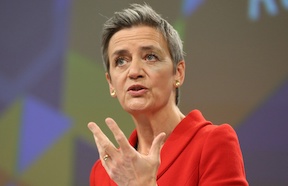The US and EU celebrated a transatlantic partnership reinvigorated in part by its unprecedented cooperation against Russia’s invasion of Ukraine, but the public unity masks festering trade and technology disputes.
When the second Trade and Technology Council wrapped up outside Paris on Monday, EU and US officials focused on their coordination on sanctions and export controls against Moscow.
The TTC “has allowed us to push back against the harmful behavior of non-market economies like Russia,” US Commerce Secretary Gina Raimondo told reporters. Work through the TTC allowed both sides to “hammer Russia with extreme export controls, essentially cutting them off from all the advanced technology that they need to conduct their military operations” in Ukraine, she said.
But the EU and US still face unresolved trade fights started under the presidency of Donald Trump, questions over how to work with China and upcoming showdowns over tech regulation. The EU’s digital and competition chief Margrethe Vestager acknowledged that the two sides don’t see eye-to-eye on certain topics.

“We can disagree within the Trade and Technology Council, because the starting point of agreeing is usually disagreeing,” Vestager said on Sunday. Eventually, she added, they might find alignment.
Tough Trade
Lingering issues related to Trump-era steel and aluminum tariffs underscore the limits of the transatlantic goodwill. The dispute started in 2018, when Trump imposed duties on steel and aluminum from Europe, Asia and elsewhere, citing risks to national security.
And while a truce has since been reached on the tariffs, the US has refused to remove EU steel and aluminum from the list of products considered a threat to its national security. The EU always rejected the premise that production from the bloc presents a national security threat.
Ahead of the TTC, the EU wanted to tackle the issue by pushing for a line in draft TTC conclusions seen by Bloomberg saying that “specific products traded between the EU and US cannot be considered a national security threat.” The line was absent from the final conclusions.
The EU’s trade chief, Valdis Dombrovskis, acknowledged that an agreement on steel and aluminum tariffs should be finalized by October of next year, but that work could be handled outside the TTC. Officials have taken that route with other contentious debates including talks on data flows, where the EU and US are still working out technical details after a political agreement.
Tech Talks
Vestager also said there’s no ambition to restart trade talks with the US after the failed Transatlantic Trade and Investment Partnership, saying “we’ve moved beyond it.”
“It seems sort of a bit old school to think about a traditional free trade agreement,” Vestager said. “We have a completely different chance of shaping a relationship where trade plays a different role and in that combination with technology enables us to address some of the questions that we’re both struggling with.”
Officials said the next meeting in December is when the TTC needs to deliver more concrete results. “This is the first step but we need to enhance the process to go beyond just information sharing,” said the EU’s internal market commissioner, Thierry Breton
Progress has been made in some areas, particularly on technology issues. The EU agreed to coordinate principles of semiconductor subsidies, something the bloc was previously hesitant about.
Raimondo, who previously spoke out against the Digital Markets Act for unfairly targeting US companies, told Bloomberg that the EU and US will be able to harmonize approaches. “We are definitely moving into an era of more tech regulation,” she said.
But it’s not certain how long the two will stay on the same page. Some of the language against disinformation was toned down due to domestic concerns from the US.
And there could be a fight coming after the EU raised the idea of forcing internet streaming services like Netflix and YouTube to pay a fee to telecom companies to help them invest in expensive 5G infrastructure. The US has fought against similar ideas in the past.
“Like all of these ideas, they have some merit,” Raimondo said, but she added that it’s at a “very preliminary” stage of discussion.







